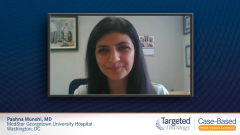
Real-World Efficacy Data for Ruxolitinib in Steroid-Refractory cGVHD
A comprehensive review of recent real-world ruxolitinib efficacy data and the use of emerging prognostic markers to risk-stratify patients with cGVHD.
Episodes in this series

Case: A 58-Year-Old Man With Moderate Steroid-Refractory Chronic Graft-Versus-Host Disease
Initial Presentation
- A 58-year-old man previously underwent myeloablative conditioning and an allogeneic PBSC transplant for acute lymphocytic leukemia
- Received tacrolimus and methotrexate for GVHD prophylaxis
- At 10 months post-transplant, patient developed moderate muscle and joint pain with decreased range of motion, mild erythematous rash on cheeks
First-line Treatment
- Patient received topical steroid cream for rash, and was started on oral prednisone at 1 mg/kg/day
- After 4 weeks of treatment, the patient’s rash resolved but muscle/joint pain continued
Second-line Treatment
- Patient is now receiving ruxolitinib 10 mg orally twice daily, alongside 1 mg/kg/day steroids
Pashna Munshi, MD: This is exciting to see that the drug solution was approved and we already have the ability to see that it's been used aggressively and actively in the real world and that we have data to show for. Dr Jennifer White and colleagues reported the real-world experience [RWE] initially at ASH [American Society of Hematology meeting] 2020 in 47 chronic GvHD [graft-vs-host disease] patients showing a 36% overall response rate at 6 months. And then they expanded this to include 115 patients from 5 different centers all the way from 2016 to 2021 and they again evaluated overall response rates, failure-free survival, as well as overall survival. They also explored some prognostic factors that were associated with clinical outcomes. And what they noted is that most of the patients initially started with ruxolitinib in at 10 or 20 mg daily as the initial dose. And then they were maintained at 20 mg daily in 2 divided doses and then they evaluated them at months 3, 6, and 12. And what they noted is that the overall response rate was attained in 47% patients at 3 months and that improved to about over 60% percent at 6 and 12 months. This is like the 50% almost overall response rate at 6 months in the REACH3 data. What they also showed is that more than half of these patients could taper the prednisone doses below 0.1 mg per kg per day. Again, like the REACH3 design showing that patients were able to come off steroids. Now the interesting thing about the real-world data is that they found 2 variables that significantly had a higher risk of failure of treatment. And based on these variables, they generated a risk or model and the 2 variables were if patients had severe chronic GvHD burden at the time of initiation of ruxolitinib or if they had a high comorbidity index that's the HCT-CI score of 3 or higher. And based on this risk model that predicted for failure-free survival they showed that people who had a score 0 which is did not have these 2 variables that they had a failure-free survival score of 86% at 12 months compared to 36% if they scored 2 at 12 months. Again, that shows that having severity of chronic GvHD is a bad prognostic marker so probably trying to understand how to identify and treat these patients sooner before they progress to severe chronic GvHD and other co-morbidities that also affect the outcomes.
Transcript edited for clarity.







































